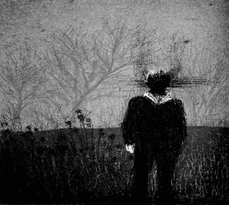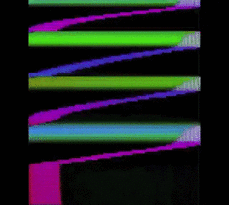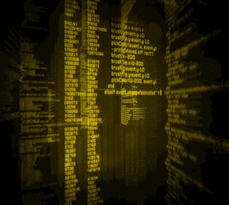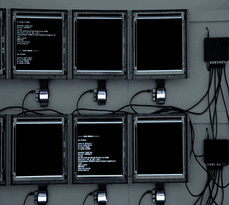Panopticon
Panopticon
We are watching you. Yes, you… You may ask who we are, but who are you? When you’re being watched, who do you become? Do you watch every move, or carry on with life, or become someone else? Like, right now, as you read this, someone could be watching through the camera (don’t check; you’ll give yourself away). You’re in the Panopticon – a circular prison with cells arranged around a central watchtower, from which prisoners can be observed at all times. Since it was developed in 1785, the Panopticon has developed from the material to the technological, where our public and private lives are constantly under surveillance. Today, this practice has become more intrinsic to our communities: from government espionage to those travel discounts that pop up on Facebook seconds after searching a trip to Argentina.
The Evolution of Surveillance
Surveillance, the integral feature of the Panopticon, has changed over time. Our anthology begins in the 17th Century, with John Donne’s The Apparition and Mary Shelley’s Frankenstein, before the concept of the Panopticon was solidified. At this time, society took a more physical approach to surveillance, believing in supernatural surveillance (haunting) and observational learning. In contrast to current technological surveillance, John Donne’s The Apparition and chapter Twelve of Mary Shelley’s Frankenstein – both written before the development of mass surveillance – present a more physical form of surveillance. The speaker in The Apparition relies on supernatural beliefs for his speech; he is bitter about romantic rejection and responds by threatening to die and silently haunt his lover by her bedside. Similarly, in chapter Twelve of Frankenstein, the Panopticon structure is revealed in this early example of surveillance when the Monster watches the family to learn more about human behaviour. The Monster hides between the trees and silently observes the family in the cottage, fascinated by their sense of companionship, which contrasts the discrimination he himself faced. The speaker in The Apparition and the Monster have more limited means than the camera and the tactics used by government bodies, as a result of the period in which the texts were written.
In the twenty-first century, ideas of surveillance have been revolutionised by technology and government authoritarianism. State surveillance is implied in Golan Haji’s Eyes, Rockwell’s Somebody’s Watching Me, Joe McAlister’s Webcam Poetry and Savita Tyagi’s We are Being Watched, where there is a possibility that the subject is being monitored through the cameras around them. Entities like the IRS are a focus in Somebody’s Watching Me, where the lyrics show the impact of surveillance on the development (or deterioration) of the human psyche. This is also explored by the speaker in We are Being Watched, who claims to be wary of the ‘camera and its eye everywhere’, implying a sense of omnipresence of surveilling entities, particularly in our private lives. This is currently a heavily scrutinised issue, as seen with events like the 2018 Cambridge Analytica scandal, where individuals found that Facebook was collecting their personal data without their consent, and selling it to third parties. These instances show the inescapability of surveillance, also explored in Eyes, where ‘shadows imprison you’ like in a Panopticon prison: you cannot even trust your own shadow. Eyes, written in the backdrop of the Syrian civil conflict, emphasises the paranoia and confusion one feels in the midst of constant surveillance from government agents. Concerns about the power of surveillance are reflected in various texts throughout the anthology, exploring concepts of mass surveillance, facial recognition, and data privacy.
Similarly, the project Webcam Poetry brings our attention to the CCTV cameras which have become a common feature in many societies. In 2015, there were thought to be around 4-6 million CCTV cameras in the UK alone (BSIA), with facial-recognition cameras deployed across London earlier this year (BBC 2020). Webcam Poetry uses CCTV feed from around the world to create poetry. Unlike other texts in the anthology, which are the product of human intervention, Webcam Poetry is created by a computer programme which ‘writes’ pieces based on the image from the feed. Technology acts as the author, with McAlister’s role in the production and distribution of the project questioned. The capability of computerised surveillance shown in this piece taps into current fears about the possibility of technology becoming sentient, but the project also raises questions about how data from surveillance is used.
Like the constant evolution of surveillance, the structure of anthologies is constantly developing as a result of technological advancements. Our online anthology allows for a more dynamic array of texts to be presented with a variety of genres, from classical literary texts to visual footage. For example, it would be impossible to show Webcam Poetry and the music video of Somebody’s Watching Me in a book format. This anthology introduces the audience to a collection of literary texts that range from 17th century individual surveillance to mass surveillance, available through an online format. The evolution of surveillance tactics is not only one that is from the physical to the technological. The extracts in unison seem to exhibit a change and evolution in the motivations as well.
Motivations and Effects of Surveillance
There are vast implications behind surveillance that may raise many questions. What drives someone to obsessively monitor another? How much power does the subject really have?
The Apparition which sees a man observe his previous lover from beyond the grave, explores the harmful results of romantic infatuation. Although the speaker threatens to haunt his partner, the subject is likely unaware that she is being watched, as many victims of surveillance are often oblivious to their observer. The song Somebody’s Watching Me discusses how it feels to be under constant surveillance, leading to anxiety and possible paranoia for the individual, when they cannot find definite proof that they are being watched. The plausible events described in the song imply that surveillance is not only a practice between powerful companies, but it can affect anyone in their everyday life. This, in turn, raises the question of why someone would want to observe an ordinary person, highlighting the threatening nature of the Panopticon, from whose gaze nobody can escape.
Paranoia can be common in the Panopticon-style environment, where an individual cannot tell whether they are being watched. This can be seen in both Eyes and Somebody’s Watching Me. The chorus of Somebody’s Watching Me repeats: ‘I always feel like somebody’s watching me’, and this feeling leads individuals like the speaker in Eyes to believe that the ‘present is an eye with amputated lids’, where they have to be vigilant. In a situation where there is a known or even a perceived threat of surveillance, everyone must keep their eyes open, to guard against the threat of surveillance and the possibility of becoming alienated if our personal information is exposed. Savita Tyagi’s We Are Being Watched explores paranoia, particularly around technology and its heavy influence in our lives. Tyagi believes that everybody should be aware of the possibility of surveillance, as it can take place inside our own homes. Through each text and its unique context, the threat of surveillance creates a similar environment which breeds paranoia, as the organisation carrying out the surveillance often does so as a way to pressure their subject into self-censoring or institutionalising their behaviour.
The interlacing connection between motivation and the underlying reasons for surveillance is what this anthology aims to examine through each text. As we delve into this anthology it is important to note that there are stories behind both the observer and the observed. Just as with Bentham’s original concept of the Panopticon prison, when surveillance takes place, people make conscious decisions to change their behaviour. However, as time goes on, these decisions become more habitual, and therefore subconscious, because being surveilled becomes an intermittent constant. There are differing motivations between both the surveillant and the surveilled, and while some of the latter are capable of rebellion against their ‘guards’, what do the former gain from their practice? The motivations behind surveillance are rarely straightforward, but this anthology aims to further examine the purpose and influence of surveillance.
Blurred Perspectives
Many of the texts present surveillance from a single perspective, either from the observer or the observed. This reinforces the ambiguity of the situation, particularly highlighting the rights of both parties involved in the process. As a result, the question of whether surveillance is taking place creates physical and psychological limitations that construct the behaviour of the subject, but also of the observer. There is a sense of powerlessness in every text included in this anthology, as we aim to portray the power dynamic intrinsic to surveillance, and allow the audience to better understand the impact that this practice can have for all involved.
Through Webcam Poetry, the author and his audience learn more about the relationship between technological surveillance and human behaviour from everyday life. The people in the footage are not individuals like the characters that the Monster observes in Frankenstein, but rather, they form a collective that allows McAlister to highlight the issue that surveillance poses on the relationship of confidence between the community and the institutions meant to represent them. There is no indication that the people in the feed have knowledge that they are being recorded, or that they have provided authorisation for such a project. However, McAlister’s easy access to the live feed also questions how an individual with no association to powerful corporations is able to participate in the breach of personal information of individuals.
Alternatively, John Donne’s The Apparition explores the correlation between surveillance and romantic obsession, as the speaker threatens to haunt his lover if she leaves him. Importantly, this poem only portrays the man’s perspective and creates an uncomfortable environment, by combining the supernatural with sexual tension. Despite remaining the only speaker throughout the poem, the speaker can only make empty threats, and his supernatural voyeurism would have gone unrecognised by his lover, fracturing his desire for control and highlighting his lack of influence in their relationship. In the end, the woman remains stronger, because she makes the final decision, regardless of his speech. Unlike the Monster in Frankenstein, and the collective in Webcam Poetry, the speaker in The Apparition seems to have no power over himself or his lover. His mental state seems deteriorated through his words, and the helplessness shown in his distressful speech only serves to highlight the futility of his desire to control his lover.
This anthology provides the audience with both sides of the narrative, incorporating texts which describe the process of surveillance from the observer’s and the subject’s perspectives. Unlike the later texts, where cameras are used for surveillance, the earlier texts focus on human surveillants who perpetually observe their subject. The Apparition, Frankenstein and Webcam Poetry all deal with the observer’s point of view, detailing the process and reasoning behind their practice: whether they seek to control or understand their subject. On the other hand, We Are Being Watched, Eyes and Somebody’s Watching Me use imagery and graphic description to capture moments of everyday life from the perspective of an individual constantly under surveillance. These texts deal with the prospect of surveillance, and how this can create an environment of uncertainty, censorship and emotional anxiety. Although this creates a cyclical structure that reflects the Panopticon theory of constant surveillance, the anthology also nuances our understanding of the Panopticon structure by suggesting that the observer is equally trapped in the structure, as they become dependent on their practice to maintain their power.
Conclusion
Our anthology aims to explore the influence that surveillance has on all parties involved. There is a great need to look at texts like the ones in this anthology, as they allow us to assess the unsettling developments in our own current reality. Social regulation seems to be the motivation of the governments alluded to in We are Being Watched, Eyes and Somebody’s Watching Me, whilst an exploration of individual power and psyche is more evident in The Apparition, Frankenstein and Webcam Poetry. Surveillance becomes internalised when the subject experiences feelings of anxiety even without substantial proof, meaning that the effects of surveillance are long-lasting, and the individual’s behaviour may change drastically as a result, even when there is no real danger. In the end, this anthology seeks to allow the audience to see beyond the apparent, and explore the issue of surveillance from different perspectives. We hope you can better understand that surveillance is more than within the government and global corporations; it can start with your neighbour, your lover and, sometimes even yourself. This anthology takes you on a journey, showing you the various faces of surveillance and the pressures of the Panopticon.
Remember we are always watching you…





